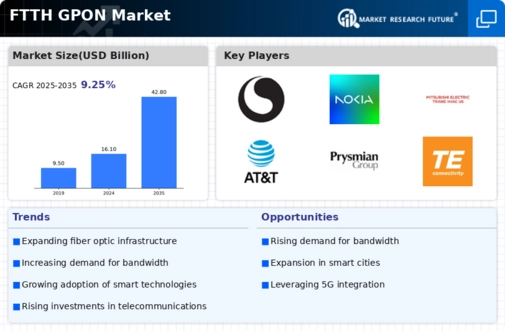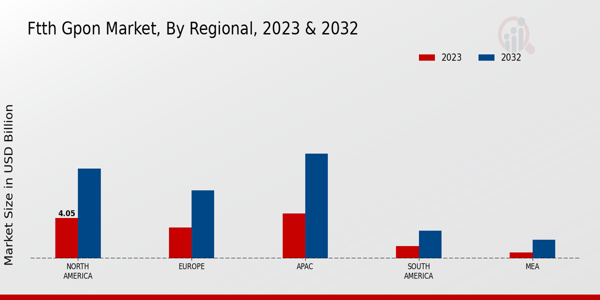Market Growth Projections
The Global FTTH GPON Market Industry is projected to experience substantial growth over the next decade. With a market value of 16.1 USD Billion in 2024, it is expected to reach 42.8 USD Billion by 2035. This growth trajectory indicates a compound annual growth rate of 9.26% from 2025 to 2035. Such projections reflect the increasing investments in fiber optic infrastructure, the rising demand for high-speed internet, and the ongoing technological advancements in the sector. As the market evolves, it is likely that new opportunities will emerge, further contributing to its expansion.
Growing Importance of Cloud Services
The growing importance of cloud services is reshaping the Global FTTH GPON Market Industry. As businesses and individuals increasingly rely on cloud-based applications for data storage, collaboration, and software solutions, the demand for robust internet infrastructure becomes critical. FTTH GPON technology offers the high-speed connectivity required to support these services, ensuring seamless access and efficient data transfer. This trend is likely to accelerate as more organizations migrate to cloud platforms, further driving the need for fiber optic networks. The market's trajectory suggests that the integration of cloud services will be a key factor in its growth over the coming years.
Rising Demand for High-Speed Internet
The Global FTTH GPON Market Industry experiences a surge in demand for high-speed internet services, driven by the increasing reliance on digital platforms for work, education, and entertainment. As of 2024, the market is valued at approximately 16.1 USD Billion, reflecting a growing consumer preference for faster and more reliable internet connections. This trend is particularly evident in urban areas where the proliferation of smart devices and IoT applications necessitates robust broadband infrastructure. The shift towards remote work and online learning further amplifies this demand, suggesting that the market will continue to expand as consumers seek enhanced connectivity.
Government Initiatives and Investments
Government initiatives play a pivotal role in the expansion of the Global FTTH GPON Market Industry. Many countries are implementing policies and funding programs aimed at improving broadband access, particularly in underserved regions. For instance, various governments are allocating significant budgets to support the deployment of fiber optic networks, which are essential for FTTH GPON technology. These investments not only enhance connectivity but also stimulate economic growth by attracting businesses and creating jobs. As a result, the market is poised for growth, with projections indicating a rise to 42.8 USD Billion by 2035, driven by these supportive governmental measures.
Technological Advancements in Fiber Optics
Technological advancements in fiber optics are significantly influencing the Global FTTH GPON Market Industry. Innovations such as improved fiber materials and enhanced transmission techniques are enabling higher data rates and increased network efficiency. These advancements facilitate the deployment of FTTH GPON solutions that can support the growing bandwidth demands of consumers and businesses alike. As technology continues to evolve, it is likely that the market will witness a proliferation of new applications and services, further driving growth. The anticipated compound annual growth rate of 9.26% from 2025 to 2035 underscores the potential for ongoing innovation in this sector.
Increased Adoption of Smart Home Technologies
The increased adoption of smart home technologies is a significant driver of the Global FTTH GPON Market Industry. As consumers invest in smart devices such as security systems, thermostats, and lighting controls, the demand for high-speed internet connections becomes paramount. FTTH GPON networks provide the necessary bandwidth to support multiple devices operating simultaneously without compromising performance. This trend is particularly pronounced in regions with high disposable incomes, where consumers are more likely to invest in smart home solutions. Consequently, the market is expected to expand as more households transition to smart living environments, thereby increasing the need for reliable fiber optic connectivity.










